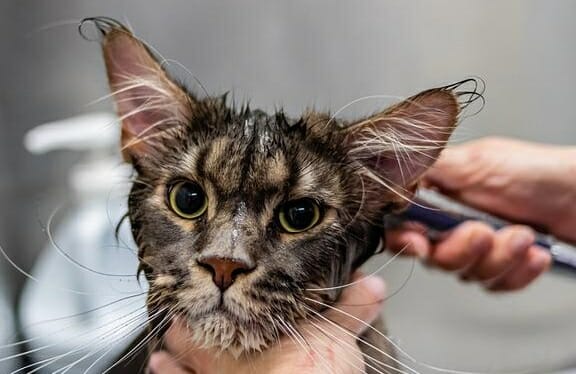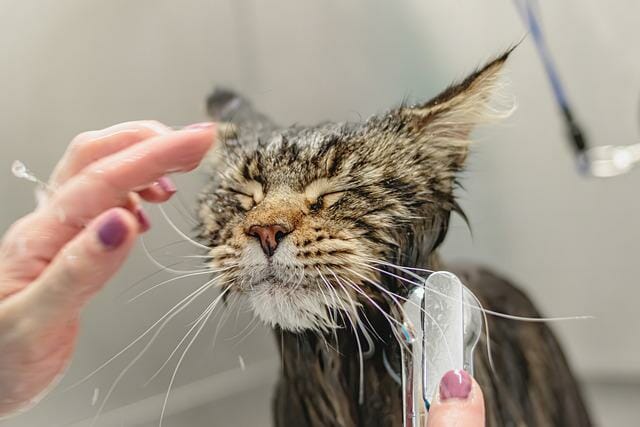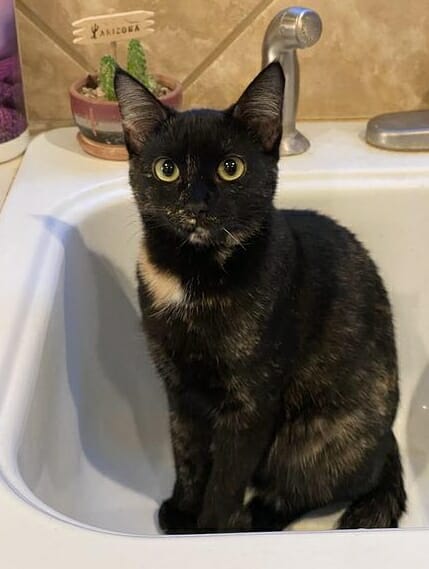Best Way to Bathe a Cat: Things to Keep in Mind When Giving Your Cat a Bath
The best way to bathe a cat is by using warm water and cat-specific shampoo. Start by filling a sink or a bathtub with a few inches of warm water. Ensure the water is not too hot, as cats are sensitive to temperature changes. Wet your cat’s fur with a handheld shower nozzle or a cup of water. Avoid getting water in your cat’s ears and eyes.
Apply a small amount of cat shampoo to your cat’s fur and lather it gently. Make sure to use a shampoo specifically designed for cats, and avoid using human shampoo, as it can be too harsh for their skin. Then, rinse your cat thoroughly with clean water and remove all the shampoo.


Use a towel to dry your cat’s fur gently. Avoid using a hairdryer, as the noise and airflow can be stressful for your cat. Instead, reward your cat with a treat or a favorite toy to help them associate bathing with positive experiences.
Table of Contents
Things to Remember When Bathing a Cat
Use a Cat-Specific Shampoo
Using cat-specific shampoo when bathing a cat is essential to ensure the safety and well-being of your feline friend. Cats have a different pH balance on their skin than humans; using human shampoo can disrupt this balance. In addition, cat-specific shampoos are formulated to have a pH balance suitable for cats, which helps to maintain healthy skin and coats.
Human shampoos often contain fragrances and other irritants that can cause skin irritation and discomfort in cats. Cat-specific shampoos are typically fragrance-free and contain gentle, non-irritating ingredients that are safe for cats.
Many cat-specific shampoos are also formulated to help prevent fleas and ticks from infesting your cat’s fur. These shampoos contain ingredients such as pyrethrins or permethrin, which are safe for cats and effective in killing fleas and ticks. Some cat shampoos contain moisturizing ingredients that help keep your cat’s skin and coat healthy and hydrated. This can be important for cats with dry or sensitive skin.
Furthermore, using a cat-specific shampoo ensures that you use a product specifically designed and tested for use on cats. This can help minimize the risk of adverse reactions and other health problems when using human products on cats.
Use Warm Water
Using warm water when bathing a cat is important for several reasons, as it can help to make the experience more comfortable and less stressful for your feline friend. Warm water can help relax your cat and make them more comfortable during the bath. It can also help to soothe any aches or pains they may be experiencing, which can be particularly beneficial for older cats or cats with arthritis.
Cats are sensitive to temperature changes, and cold water can be uncomfortable and stressful. Using warm water can help to create a more relaxing and enjoyable bathing experience for your cat. Warm water is also more effective at removing dirt, debris, and oils from your cat’s coat. It can help loosen dirt and grime, making washing away during the bath easier.


Using too hot water can be dangerous for your cat, as it can cause burns and scalds. Conversely, using water that is too cold can cause your cat to become uncomfortable and stressed. By using warm water, you can help ensure the bath is safe and comfortable for your cat.
In addition, warm water can help to promote healthy skin by opening up pores and increasing blood flow to the skin’s surface. This can help to remove toxins and promote the growth of healthy skin cells.
Protect Their Ears
Water can easily enter your cat’s ears during the bath, which can cause irritation, discomfort, and even infection. This is especially true if your cat is prone to ear infections, has a history of ear problems, or has long ears that are more difficult to protect. As such, protecting your cat’s ears when bathing them is important to ensure their safety and comfort during the bath.
Cats’ ears are sensitive and can be easily irritated by water, shampoo, or other products that come into contact with them. Protecting your cat’s ears during the bath can help minimize the risk of irritation and discomfort.
Protecting your cat’s ears during the bath can also help to prevent accidents and injuries. For example, if your cat becomes agitated or stressed during the bath, it may try to jump or escape, which can lead to injury if its ears are not protected.
To protect your cat’s ears during the bath, you can use cotton balls or earplugs to prevent water and shampoo from entering their ears. Make sure to gently place the cotton balls or earplugs in their ears and remove them carefully after the bath. Avoid using cotton swabs or other objects that could damage your cat’s ears.
Be Gentle
Cats are sensitive creatures and can easily become injured or traumatized if handled roughly during the bath. This can cause physical harm, such as scratches or bites, and emotional harm in the form of fear, anxiety, or stress. Being gentle can help to ensure their safety, comfort, and well-being during the bath.


Also, cats are naturally anxious and cautious animals, and they can become easily stressed when exposed to new or unfamiliar situations. Being gentle and calm during the bath can help promote relaxation and ease, making the experience more comfortable for your cat.
Rough handling can lead to skin irritation, which can be uncomfortable and painful for your cat. This can be particularly problematic if your cat has sensitive skin, allergies, or other skin conditions.
Building trust with your cat is an important part of the bathing process, as it can help to create a positive association with the experience. By being gentle and patient, you can demonstrate to your cat that they are safe and cared for, which can help to build trust and reduce fear and anxiety in the future.
Finally, being gentle when bathing your cat can help to ensure their cooperation during the process. For example, if your cat feels threatened or uncomfortable, it may become agitated and uncooperative, making it difficult to complete the bath.
To be gentle when bathing your cat, it’s important to move slowly and avoid sudden movements that could startle or upset them. Use gentle, circular motions to massage shampoo into their fur, and avoid tugging or pulling on any mats or tangles. Use a soft, damp cloth to clean your cat’s face and head, and avoid getting water or shampoo in their eyes or ears.
